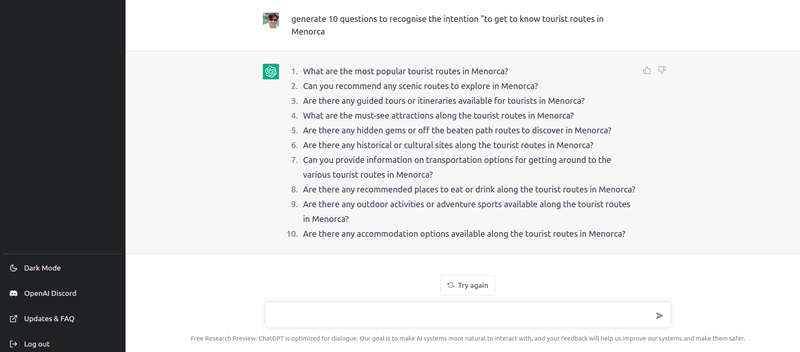Dec. 15, 2022 · 3 min read

In recent weeks, people have been talking about the revolution generated by ChatGPT in the field of natural language processing (NLP) and its infinite applications.
In a nutshell, ChatGPT is a language model developed by OpenAI that can be used in a variety of applications related to text generation, automatic translation, and much more helping to improve efficiency and accuracy in many tasks that require NLP. It is a variant of the GPT-3 model that has been specifically optimized for the task of generating conversational responses. It is designed to be able to generate human-like responses to natural language input, allowing you to participate in a conversation in a way that is hard to distinguish from a real person.
It is not a stand-alone product or tool, but rather a research project focused on advancing the state of the art in NLP.
Among the multiple tasks that can be done with CHATGPT, in addition to answering questions and maintaining conversations with users in a natural and fluid way, it could also be used in tasks such as document classification, sentiment detection in texts or generation of articles, headlines, among others. The applications of CHATGPT are very wide and can be used in a variety of different contexts where the understanding of natural language by machines is essential.
Given the versatility of this model of having the ability to generate text following a few instructions, apsl.tech has used GPT-3 and its variant CHATGPT as a useful tool for the generation of synthetic corpus and creation of artificial text sets that can be used to train intent-based chatbots.
Synthetic corpus generation with CHATGPT can be very useful in situations where there is not enough real data to train a bot. For example, if you want to develop a bot that can answer questions on a very specific topic, you may not have a large enough corpus of real data to train it effectively.
In this case, GPT-3 and CHATGPT can be used to generate artificial text that can be used to train the bot. The texts are realistic and varied enough for the bot to convincingly answer questions.
To do this, what we've done is to specify the intents we want to capture in the corpus, and then ChatGPT can be used to generate text that matches those intents. Once you have the generated synthetic corpus, you can use it to train a chatbot based on detecting these intents so that your bot can accurately and efficiently respond to user queries.
Here's an example of how ChatGPT could be used to generate a synthetic corpus that can be used to train an intent-based chatbot.
First, you would need to specify the intents that you want to capture in the corpus. For example, suppose we want to train a chatbot that can answer questions about the weather. In this case, the intentions could be "check the weather forecast," "find out if it's going to rain today," and "get information about the temperature."
Once intents have been specified, ChatGPT can be used to generate text that conforms to those intents. For example, if ChatGPT is given the intent "check the weather forecast", its output text is like this:

In this way, a synthetic corpus can be generated that contains a variety of sample questions that a user might ask to check the weather forecast. That corpus can then be used to train a chatbot that can accurately and efficiently answer questions about the weather.
In short, both GPT-3 and its variant ChatGPT are very useful tools in the field of natural language processing due to their ability to generate text autonomously. It is especially useful in situations where there is not enough real data to train a chatbot. This makes it a very valuable piece for the creation of synthetic corpus that can be used to train bots.
Overall, ChatGPT is a very promising solution for chatbot development in data-scarce situations.